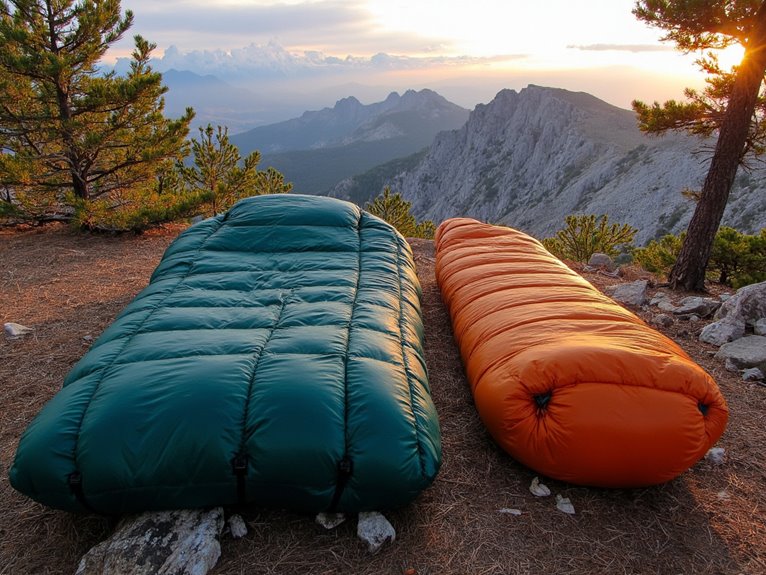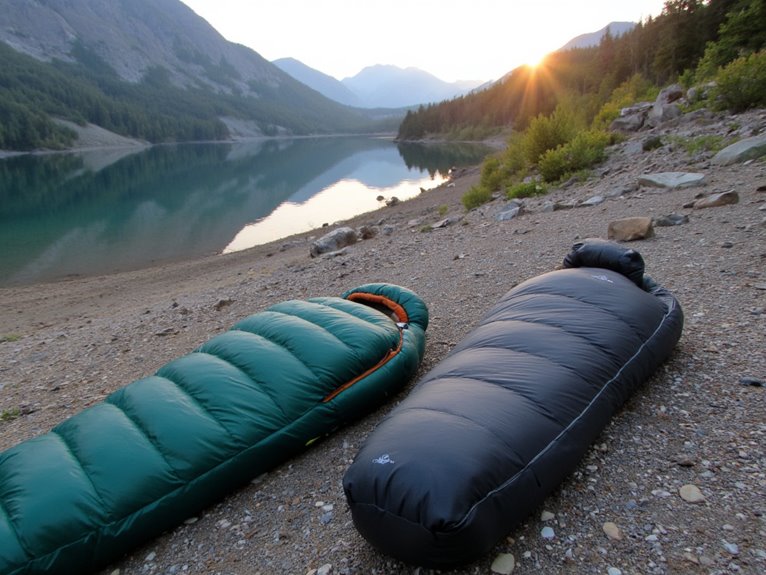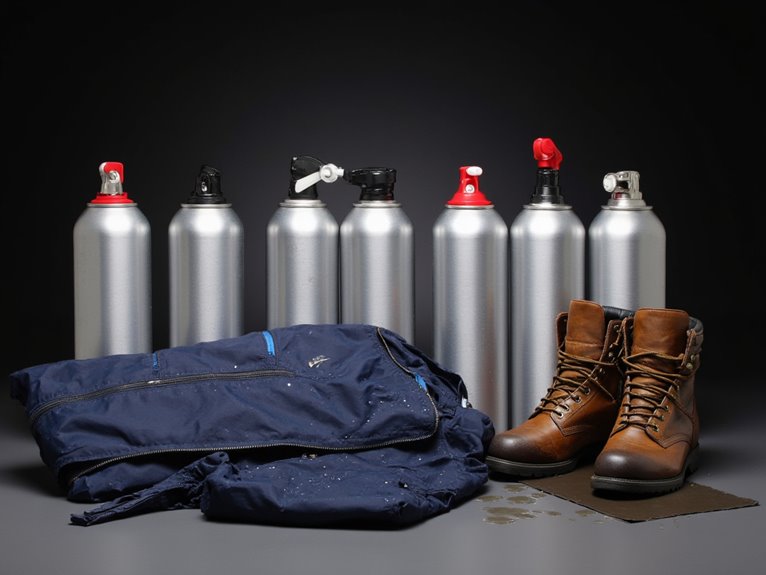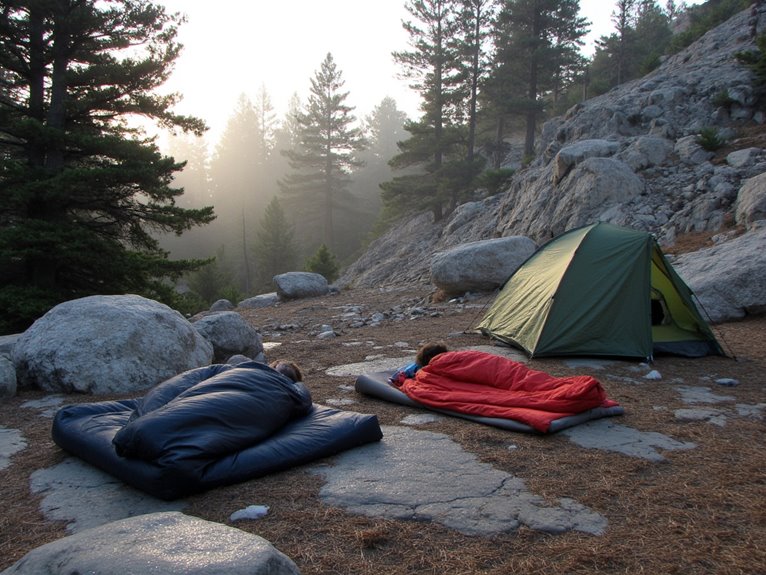Sleeping Quilt vs. Sleeping Bag: Which Is Better for Backpacking?
You’ll save 17% weight with quilts compared to sleeping bags, like the REI Co-op Magma 30 quilt at 20.3 oz versus its bag counterpart at 24.4 oz. Quilts excel in mild conditions above freezing with superior packability, while sleeping bags outperform in sub-freezing temperatures through enclosed designs and hoods. Quilts require 2-3 minute setup versus 30 seconds for bags, but offer better temperature regulation flexibility. The choice depends on your specific backpacking conditions and priorities, with deeper considerations ahead.
We are supported by our audience. When you purchase through links on our site, we may earn an affiliate commission, at no extra cost for you. Learn more. Last update on 25th December 2025 / Images from Amazon Product Advertising API.
Notable Insights
- Quilts save approximately 17% weight and pack smaller than sleeping bags, making them ideal for ultralight backpacking.
- Sleeping bags perform better in cold, windy conditions below freezing due to hoods and full enclosure design.
- Quilts excel in mild weather above 30°F with superior temperature regulation and freedom of movement for restless sleepers.
- Setup time favors sleeping bags at 30 seconds versus 2-3 minutes for quilts requiring pad attachment systems.
- Cost varies widely with budget sleeping bags starting at $50 while quilts offer better warmth-to-weight ratios per dollar.
Weight and Packability Comparison for Backpackers
When every ounce matters on the trail, quilts deliver a significant weight advantage over traditional sleeping bags. You’ll save approximately 17% weight by choosing a quilt over a comparable sleeping bag. The REI Co-op Magma 30 Down Trail Quilt weighs 20.3 oz compared to 24.4 oz for its sleeping bag counterpart—a 4.1 oz difference that adds up quickly.
This material efficiency stems from quilts’ open-back design, eliminating unnecessary fabric, zippers, and hoods.
You’ll also gain superior packability since quilts compress into smaller volumes than traditional sleeping bags. The reduced bulk frees up valuable backpack space for other essential gear.
Your user experience improves with enhanced freedom of movement while maintaining warmth efficiency.
Quilts attach directly to sleeping pads, creating an integrated sleep system that maximizes thermal performance without excess weight. For backpacking, the optimal weight for sleep systems should be between 4-8 pounds for car camping, though ultralight backpacking options prioritize minimal weight for enhanced hiking efficiency.
Warmth Performance in Different Weather Conditions
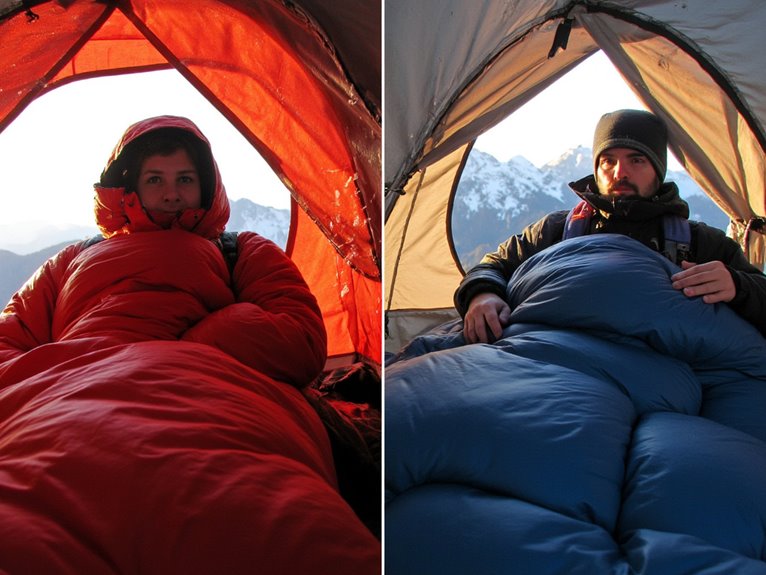
Although weight savings matter greatly on the trail, warmth performance ultimately determines your comfort and safety during backcountry sleep. Different insulation types perform distinctly across varying conditions, making weather adaptability essential for gear selection.
Sleeping bags excel in cold, windy environments through their fully enclosed design and standardized EN/ISO temperature ratings. Hoods and draft collars eliminate heat loss pathways that compromise warmth. Even basic hooded bags outperform quilts in extreme conditions.
In extreme cold and wind, sleeping bags’ enclosed design with hoods and draft collars consistently outperforms quilts for reliable thermal protection.
Quilts offer superior warmth-to-weight ratios with concentrated insulation on top and sides. However, their open design creates draft vulnerabilities without proper pad attachment.
You’ll find quilts perform best in mild conditions above freezing, while bags maintain consistent thermal protection regardless of weather variability. When selecting gear for extreme cold, consider that temperature ratings from reputable manufacturers range from -35°F to 30°F, providing clear performance benchmarks for different weather conditions.
Temperature Regulation and Seasonal Versatility
Beyond initial warmth performance, your sleeping system’s ability to regulate temperature across changing conditions determines its practical versatility throughout the hiking season.
Quilts excel in moderate to warm conditions, offering superior humidity control through rapid airflow adjustments. You can expose limbs or torso instantly for cooling, while sleeping bags require zipper manipulation for ventilation.
Temperature regulation advantages by system:
- Quilts provide 30°F to 80°F comfort range with proper venting techniques
- Sleeping bags offer superior sub-freezing performance through hoods and draft protection
- Hot sleepers benefit from quilt’s open drape design for overheating prevention
- Cold sleepers prefer bag’s full closure features matching their sleeping preferences
Quilts function as blankets during hot weather but may require additional layers in extreme cold.
Bags maintain consistent warmth but limit ventilation options.
The insulation type within your sleeping system significantly affects temperature regulation, with synthetic insulation retaining heat when wet and drying faster while down provides exceptional thermal efficiency in dry conditions.
Setup Requirements and Ease of Use

Your choice between quilts and sleeping bags greatly impacts setup complexity and field usability during backpacking trips. Sleeping bags offer straightforward deployment—simply unroll and climb in. Quilts require more involved quilt attachment systems using straps or clips to secure to your sleeping pad, preventing drafts and heat loss.
| Feature | Sleeping Quilts | Sleeping Bags |
|---|---|---|
| Setup Time | 2-3 minutes with attachment | 30 seconds deployment |
| Learning Curve | Moderate practice required | Intuitive for beginners |
| Movement Freedom | High flexibility, easy repositioning | Restricted, potential tangling |
User preferences often determine which system works best. Active sleepers favor quilts’ unrestricted movement despite the complex setup. Beginners typically prefer bags’ immediate usability. Quilts demand practice mastering brand-specific attachment methods, while bags provide consistent, foolproof operation across all models.
Both systems work effectively when paired with proper sleeping pad positioning on flat ground that’s been cleared of sharp objects and debris to prevent damage. When using a quilt system, understanding your sleeping pad’s R-value becomes particularly important since the attachment method affects overall insulation performance.
Cost Analysis and Overall Value for Backpacking
When evaluating backpacking sleep systems, cost considerations extend far beyond initial purchase price to encompass weight savings, durability, and long-term value.
Quilts typically cost $100-$300, while sleeping bags range $50-$400. However, multiple cost factors influence true value.
- Initial Investment: Entry-level synthetic quilts start at $100-$150, while quality sleeping bags begin at $50-$100, giving bags an advantage for budget buyers.
- Weight-to-Cost Ratio: Quilts deliver superior value per ounce saved. The REI Magma 30 quilt weighs 17% less than its bag equivalent at similar pricing.
- Material Efficiency: Quilts eliminate wasted insulation under your body, maximizing warmth-to-dollar ratios through strategic material placement.
- Value Retention: Both high-quality quilts and bags maintain resale value when properly maintained, though fewer moving parts give quilts durability advantages.
For optimal backpacking performance, prioritize options under 3 pounds to maximize comfort without sacrificing your hiking endurance or increasing fatigue on long-distance trails.

